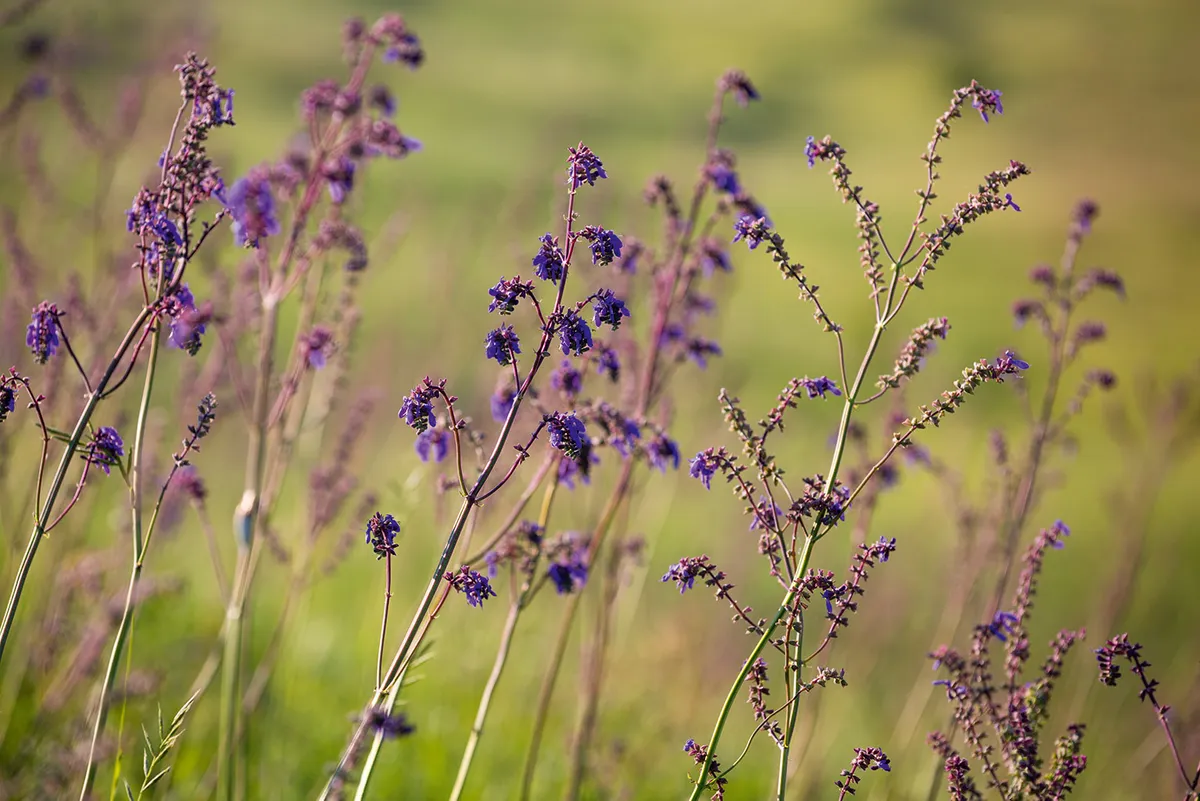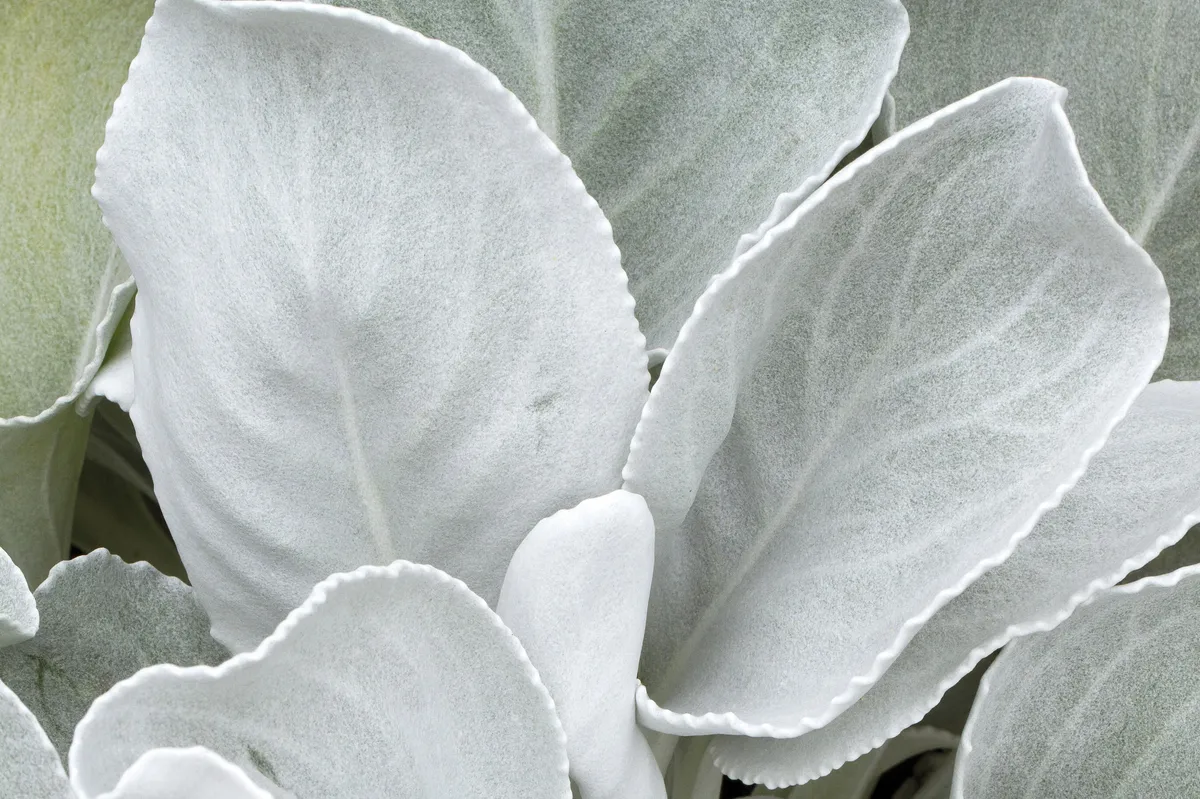Salvia nutans
Chosen by Nigel Dunnett, Professor of Planting Design and Urban Horticulture, University of Sheffield

Upright branching dark stems rise from a clump of grey-green leaves. Stems are topped by hanging clusters of intense blue flowers, pointing arrow-like towards the ground. It’s a plant of the Russian steppe, where it can grow in large colonies, and this gives a clue to how I’m going to use it: in dry meadow plantings, where the salvia flowers can dance above a matrix of tussocky grasses.
Height and spread 1.2m x 45cm.
Origin Russia and Eastern Europe.
Conditions Sun, free-draining soil, dry.
Hardiness RHS H4, USDA 4a-9b.
Season of interest June – September.
Follow Nigel at @nigel.dunnett
Helianthus giganteus ‘Sheila’s Sunshine’
Chosen by Joshua Sparkes, head gardener at Forde Abbey
Tall, elegant, with beautiful buttercream-coloured flowers atop autumnal red stems covered in canoe-shaped, crisp, green leaves. The calyx contrasts wonderfully with the flower, and winter stems and seedheads warrant waiting until spring to cut down. I plan to drift them up to the border’s edge to appreciate their beauty.
Height 2m.
Origin Garden origin.
Conditions Reasonable soil; sun or part shade.
Hardiness RHS H7, USDA 4a-8b.
Season of interest August – February.
Follow Joshua at @joshua_sparkes
Geranium 'Dark Eyes'
Chosen by Elizabeth and Alasdair MacGregor, jointly run Elizabeth MacGregor Nursery

The combination of dark foliage and bright-magenta flowers has been really eye-catching in our trials field for several seasons, so we are really looking forward to offering it for sale from spring next year and using it in our own blue-purple border alongside Iris ‘Shirley Pope’ and Iris chrysographes ‘Mandarin Purple’.
Height 60cm.
Origin Our own raising (G. pratense ‘Victor Reiter’ x G. psilostemon).
Conditions Any fertile garden soil; sun or part shade.
Hardiness RHS H7.
Season of interest From early summer.
Follow Elizabeth and Alasdair at elizabethmacgregornursery.co.uk
Mespilus germanica ‘Nottingham’
Chosen by Benjamin William Pope, head gardener in a private garden

Healthy in growth, this medlar produces simple white flowers in spring followed by unusual fruit, somewhere between a large rosehip and quince. Leathery green leaves take on buttery autumn tints as fruits begin to ripen, although they will not give up their toffee-apple flavour until bletted. Well worth a spot in any garden. AGM.
Height 4-6m.
Origin Southwest Asia, Transcaucasus.
Conditions Free-draining soil; full sun.
Hardiness RHS H6, USDA 5a-8b.
Season of interest Spring and autumn with culinary benefit.
Follow Benjamin at @theworkinggarden
Araiostegia hymenophylloides
Chosen by Jack Wallington, landscape designer
Despite its delicate look, this is a tough plant; hardy and evergreen in sheltered spots. It spreads by creeping rhizome above the soil surface to form a clump. I’m planning to move it from a pot into the soil this year, near the base of a shaded raised bed, where I hope it will creep around and up through cracks in the bricks.
Height and spread 40cm x 40cm.
Origin Southeastern Asia.
Conditions Moisture-retentive, humus-rich soil; full shade.
Hardiness RHS H5.
Season of interest Year round.
You can follow Jack at @jackwallingtongardendesign
Philadelphus ‘Manteau d’Hermine’
Chosen by Alexander Hoyle, plantsman and designer

Philadelphus, with their profusion of white, richly fragrant blooms, always makes me think of heady summer evenings, and there is one suitable for every garden. Their slightly arching stems are also beautiful used as a cut flower. Albeit a bred cultivar, I love P. ‘Manteau d’Hermine’ with its double flowers. AGM.
Height 50cm-1m.
Origin. Bred by French plantsman Victor Lemoine (species northeast Mexico).
Conditions Full sun to partial shade.
Hardiness RHS H6.
Season of interest June to July.
Follow Alexander at @alexanderhoyle
Anisodontea ‘El Rayo’
Chosen by Steve Edney, Head gardener at The Salutation
A drought-tolerant, semi-evergreen shrub that flowers almost 365 days of the year. It has a light, airy habit with lobed, hairy, mid-green leaves
and saucer-shaped, pink flowers that deepen to the centre. The shade of pink deepens in the winter at which time surprisingly the flowering increases. Looks fabulous when paired with Salvia ‘Amistad’.
Height and spread 2m x 1m.
Origin South Africa.
Conditions Free-draining soil; sun.
Hardiness RHS H2.
Season of interest Year round.
Follow Steve at @stevenedney4
Senecio candidans Angel Wings (= ‘Senaw’)
Chosen by Matthew Pottage, Curator of RHS Garden Wisley

I thought this would be difficult to please, probably needing mountain-like conditions – drainage, moisture, high light levels etc – to thrive. But then I clocked it on a friend’s Twitter feed, growing in Ireland to a mound some 50cm high and wider still. It’s hard to think of another plant with such presence.
Height 40cm.
Origin Falkland Islands, South America.
Conditions Free-draining, moderately fertile soil; full sun.
Hardiness RHS H3.
Season of interest Year round.
Follow Matthew at @matthew.pottage
Tricyrtis Formosana
Chosen by Becky Crowley, flower gardener at Chatsworth
Also known as the toad lily, which is a reference to the spotted markings on the flowers, similar to (but rather more attractive than) the blotchy skin of a toad. We’ve had Tricyrtis plants within a herbaceous border at Chatsworth for years, but the exquisite little flowers tend to get lost among a mass of other plants. They are better enjoyed close up, where you can peer down on to their intricately marked flowers that open up at the very tip of long wiry stems. This makes them a wonderful choice for using in early autumn arrangements and bouquets, where they add a touch of the exotic despite being perfectly hardy in a shady spot in Derbyshire.
Origin Taiwan and the Ryukyu Islands; a chain of islands that is part of Japan.
Conditions Humus-rich moist soil; shade.
Hardiness RHS H5, USDA 4a-9b†.
Season of interest September – October.
Follow Becky at @beckycrowley_
